- Paul Rincon
- Science Editor, BBC News
Humans arrived in America at least 7,000 years earlier than previously thought, according to new research findings.
The issue of the arrival of the first humans to the American continent has generated controversy during decades.
Many researchers are skeptical of the evidence that humans existed in North America more than 16,000 years.
Now a team working in New Mexico, United States, has found dozens of human footprints dating back to between 23,000 and 21,000 years ago.
This discovery could change the way in which it is explained when the continent was colonized.
The finding suggests that there may have been great migrations of which we know nothing.
In addition, it raises the possibility that these first populations have extinct.
The tracks formed in a soft mud on the banks of a shallow lake which is now part of White Sands National Park in New Mexico.
In the sediment layers above and below the footprints, a team from the US Geological Survey found seeds which they made radiocarbon dating.
This gave the researchers dates remarkably accurate for the footprints.
Based on the sizes of the footprints, scientists believe that they mainly belonged to teenagers and children who traveled from one place to another, occasionally accompanied by an adult.
The buffalo jump
The discovery of the footprints offers a fascinating window into how was life of these first inhabitants of what is now the southwestern United States.
Scientists are not sure what the teens were doing, but it is possible that they were helping adults with one type of hunting which was later also observed in some indigenous American cultures.
This practice was known as “the jump of the buffalo”, and implied drive animals by the edge of a shallow cliff.
All the animals “had to be processed in a short period time, ”explained Dr Sally Reynolds, a researcher at Bournemouth University and a co-author of the study.
“You had to start a fire, you had to start burning the fat.”
The teens could have been helping by collecting firewood, water, or other essential resources.
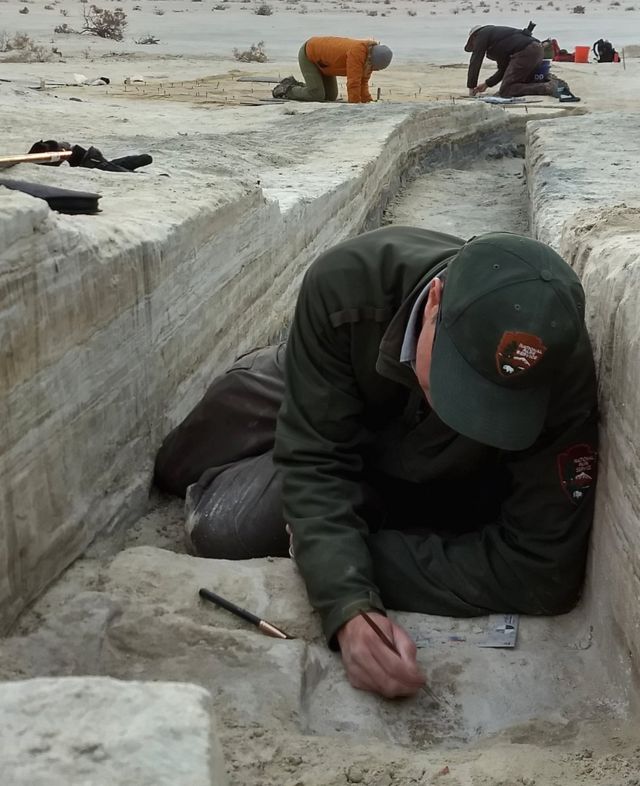
Debate
The era to which the discovery belongs is key, because there have been countless claims of human settlements early in America, but virtually all are controversial.
It often comes down to a debate about whether stone tools found at an ancient site are in fact what they appear to be, or are simply rocks that break due to some natural process, such as falling off a cliff.
The supposed artifacts found in older places sometimes have less precise cuts than the exquisitely crafted spearheads found in North America from 13,000 years onwards.
It generates Doubts on whether they were actually human-manipulated objects.
“One of the reasons there is so much debate is that there is a real lack of data firm and unequivocal. That’s what we think we probably have, ”Professor Matthew Bennett, lead author of the paper and a researcher at Bournemouth University, told the BBC.
“The tracks are not stone tools. A footprint is a footprint, and it cannot move up and down [en las capas del suelo]”.
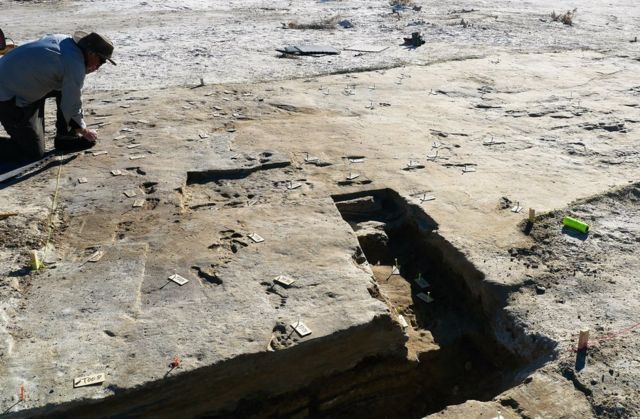
Rule out faults
If anything, the investigators made sure their evidence was without flaws.
In their study, the scientists had to rule out a possible “Reservoir effect”.
This refers to the way that carbon can sometimes be recycled in aqueous environments, interfering with radiocarbon dating results, making a site look like older than it is.
However, the team members assure that they have taken this effect into account and believe that in this case did not play a significant role.
“They have done some date checks on the material near the footprints, and found that the completely terrestrial samples (charcoal) had similar ages to the aquatic species closest to the footprints, ”Tom Higham, an expert in radiocarbon dating at the University of Vienna, told the BBC.
“They have also argued, I think rightly so, that the lake must have been shallow at the time when people were walking there, mitigating the reservoir effect generated by old carbon sources ”.
The consistency of the results and the support of a different dating technique applied at the enclave support the validity of the results, he added.
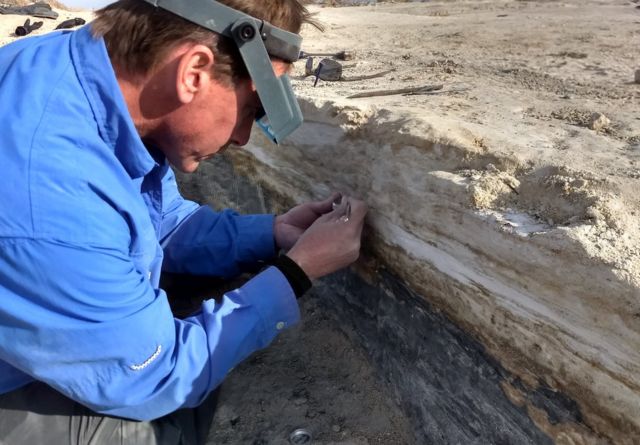
“I think that, together, this is a sequence of 21,000 to 23,000 years oldProfessor Higham told the BBC.
Challenging orthodoxy
Controversies in American archeology have much to do with the historical development of this field of study.
During the second half of the 20th century, a consensus emerged among North American archaeologists that people belonging to the Clovis culture they had been the first to arrive in America.
These hunters were thought to have crossed a land bridge across the Bering strait, which connected Siberia to Alaska during the last Ice Age, when sea levels were much lower.
As the idea of ’first came the Clovis’ took hold, reports of older settlements were discarded for not being reliable, and some archaeologists stopped looking for signs of older settlers.
But in the 1970s, this orthodoxy was challenged.
In the 1980s, strong evidence was found for a human presence of 14,500 years in Monte Verde, in Chile.
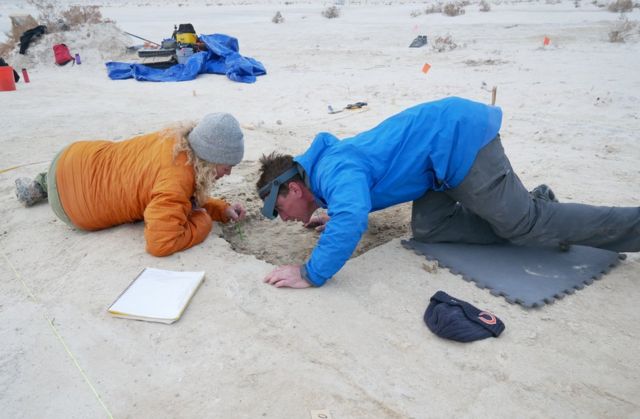
And since the 2000s, other pre-Clovis sites have become widely acceptedlike the 15,500-year-old Buttermilk Creek complex in central Texas; and the 16,000-year-old Cooper’s Ferry site in Idaho.
Now the tracks from New Mexico suggest that humans had reached the interior of North America in the heyday of the last Ice Age.
“I can’t find fault with the work that was done or the interpretations,” said Gary Haynes, professor emeritus at the University of Nevada, Reno.
“The tracks are so far south of the Bering land connection that now we have to wonder if people or their ancestors (or other people) had made the crossing from Asia to the Americas much earlier; if people moved rapidly across the continents after each crossing; and if they left decendents“.
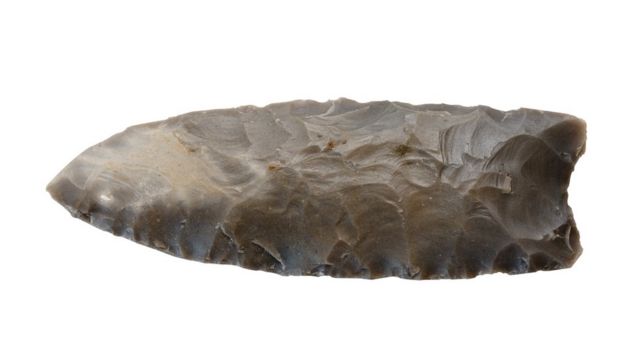
Dr Andrea Manica, a geneticist at the University of Cambridge, said the finding has important implications for the history of the population of the Americas.
“I can’t comment on how reliable the dating is (it’s outside of my area of expertise), but the firm evidence from humans in North America 23,000 years ago does not match genetics, which clearly shows a separation between Native Americans and Asians. about 15,000 to 16,000 years ago, ”he told the BBC.
“This would suggest that the initial settlers of the Americas were replaced when the ice corridor formed and another wave of settlers came in. We have no idea how that happened. “
eltiempolatino.com